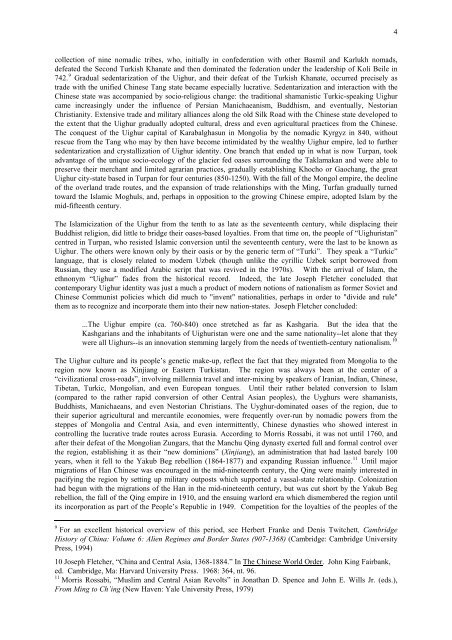Dru C. Gladney, Ph.D. - House Foreign Affairs Committee Democrats
Dru C. Gladney, Ph.D. - House Foreign Affairs Committee Democrats
Dru C. Gladney, Ph.D. - House Foreign Affairs Committee Democrats
Create successful ePaper yourself
Turn your PDF publications into a flip-book with our unique Google optimized e-Paper software.
4<br />
collection of nine nomadic tribes, who, initially in confederation with other Basmil and Karlukh nomads,<br />
defeated the Second Turkish Khanate and then dominated the federation under the leadership of Koli Beile in<br />
742. 9 Gradual sedentarization of the Uighur, and their defeat of the Turkish Khanate, occurred precisely as<br />
trade with the unified Chinese Tang state became especially lucrative. Sedentarization and interaction with the<br />
Chinese state was accompanied by socio-religious change: the traditional shamanistic Turkic-speaking Uighur<br />
came increasingly under the influence of Persian Manichaeanism, Buddhism, and eventually, Nestorian<br />
Christianity. Extensive trade and military alliances along the old Silk Road with the Chinese state developed to<br />
the extent that the Uighur gradually adopted cultural, dress and even agricultural practices from the Chinese.<br />
The conquest of the Uighur capital of Karabalghasun in Mongolia by the nomadic Kyrgyz in 840, without<br />
rescue from the Tang who may by then have become intimidated by the wealthy Uighur empire, led to further<br />
sedentarization and crystallization of Uighur identity. One branch that ended up in what is now Turpan, took<br />
advantage of the unique socio-ecology of the glacier fed oases surrounding the Taklamakan and were able to<br />
preserve their merchant and limited agrarian practices, gradually establishing Khocho or Gaochang, the great<br />
Uighur city-state based in Turpan for four centuries (850-1250). With the fall of the Mongol empire, the decline<br />
of the overland trade routes, and the expansion of trade relationships with the Ming, Turfan gradually turned<br />
toward the Islamic Moghuls, and, perhaps in opposition to the growing Chinese empire, adopted Islam by the<br />
mid-fifteenth century.<br />
The Islamicization of the Uighur from the tenth to as late as the seventeenth century, while displacing their<br />
Buddhist religion, did little to bridge their oases-based loyalties. From that time on, the people of “Uighuristan”<br />
centred in Turpan, who resisted Islamic conversion until the seventeenth century, were the last to be known as<br />
Uighur. The others were known only by their oasis or by the generic term of “Turki”. They speak a “Turkic”<br />
language, that is closely related to modern Uzbek (though unlike the cyrillic Uzbek script borrowed from<br />
Russian, they use a modified Arabic script that was revived in the 1970s). With the arrival of Islam, the<br />
ethnonym “Uighur” fades from the historical record. Indeed, the late Joseph Fletcher concluded that<br />
contemporary Uighur identity was just a much a product of modern notions of nationalism as former Soviet and<br />
Chinese Communist policies which did much to "invent" nationalities, perhaps in order to "divide and rule"<br />
them as to recognize and incorporate them into their new nation-states. Joseph Fletcher concluded:<br />
...The Uighur empire (ca. 760-840) once stretched as far as Kashgaria. But the idea that the<br />
Kashgarians and the inhabitants of Uighuristan were one and the same nationality--let alone that they<br />
were all Uighurs--is an innovation stemming largely from the needs of twentieth-century nationalism. 10<br />
The Uighur culture and its people’s genetic make-up, reflect the fact that they migrated from Mongolia to the<br />
region now known as Xinjiang or Eastern Turkistan. The region was always been at the center of a<br />
“civilizational cross-roads”, involving millennia travel and inter-mixing by speakers of Iranian, Indian, Chinese,<br />
Tibetan, Turkic, Mongolian, and even European tongues. Until their rather belated conversion to Islam<br />
(compared to the rather rapid conversion of other Central Asian peoples), the Uyghurs were shamanists,<br />
Buddhists, Manichaeans, and even Nestorian Christians. The Uyghur-dominated oases of the region, due to<br />
their superior agricultural and mercantile economies, were frequently over-run by nomadic powers from the<br />
steppes of Mongolia and Central Asia, and even intermittently, Chinese dynasties who showed interest in<br />
controlling the lucrative trade routes across Eurasia. According to Morris Rossabi, it was not until 1760, and<br />
after their defeat of the Mongolian Zungars, that the Manchu Qing dynasty exerted full and formal control over<br />
the region, establishing it as their “new dominions” (Xinjiang), an administration that had lasted barely 100<br />
years, when it fell to the Yakub Beg rebellion (1864-1877) and expanding Russian influence. 11 Until major<br />
migrations of Han Chinese was encouraged in the mid-nineteenth century, the Qing were mainly interested in<br />
pacifying the region by setting up military outposts which supported a vassal-state relationship. Colonization<br />
had begun with the migrations of the Han in the mid-nineteenth century, but was cut short by the Yakub Beg<br />
rebellion, the fall of the Qing empire in 1910, and the ensuing warlord era which dismembered the region until<br />
its incorporation as part of the People’s Republic in 1949. Competition for the loyalties of the peoples of the<br />
9 For an excellent historical overview of this period, see Herbert Franke and Denis Twitchett, Cambridge<br />
History of China: Volume 6: Alien Regimes and Border States (907-1368) (Cambridge: Cambridge University<br />
Press, 1994)<br />
10 Joseph Fletcher, “China and Central Asia, 1368-1884.” In The Chinese World Order. John King Fairbank,<br />
ed. Cambridge, Ma: Harvard University Press. 1968: 364, nt. 96.<br />
11 Morris Rossabi, “Muslim and Central Asian Revolts” in Jonathan D. Spence and John E. Wills Jr. (eds.),<br />
From Ming to Ch’ing (New Haven: Yale University Press, 1979)











![Transcript [PDF] - House Foreign Affairs Committee Democrats](https://img.yumpu.com/34524080/1/190x245/transcript-pdf-house-foreign-affairs-committee-democrats.jpg?quality=85)



